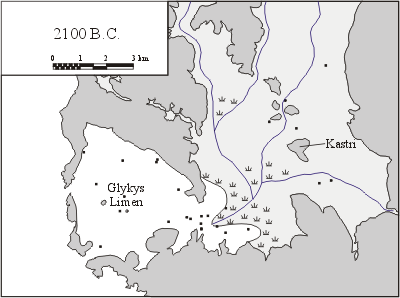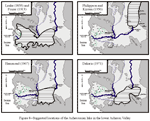Research and Projects
Besonen M.S. thesis research—The Middle and Late Holocene Geology and
Landscape Evolution of the Lower Acheron River Valley, Epirus, Greece
My Masters thesis was an interesting blend of geology and archaeology—basically, a coastal paleogeographic reconstruction using microfossils (ostracods and forams), sedimentological analyses, and historical references (ancient to modern). The subject was the lower Acheron River Valley in Epirus, Greece (clicking this link will open a Google Maps page showing the location). The work was completed at the University of Minnesota Duluth under George (Rip) Rapp, Jr. Immediately below is the thesis abstract, followed by links to the complete thesis and a publication in Adobe Acrobat PDF format. At the base of this page are some of the thesis figures, which may be of interest.
The lower Acheron River Valley, Epirus, Greece, hosts a rich, archaeological heritage dating back to the Lower Palaeolithic (Dakaris, 1971). Beginning with the Odyssey of Homer in the eighth century BC, numerous ancient authors make reference to the valley and describe a landscape configuration that is significantly different from that of the present. Three notable discrepancies concern:
1.) the size of the Glykys Limen (modern Phanari Bay),
2.) the nature, geometry, and evolution of the Acherousian lake, and
3.) the course of the Acheron River with respect to Kastri during the Classical Period.
Are these ancient authors incorrect in their descriptions of the valley, or can a natural sequence of geomorphic evolution account for such discrepancies? To answer this question, an examination of the changing paleogeography and paleoenvironmental configuration of the valley during the past 4000 years was undertaken. Twenty-eight gouge auger sediment cores were taken from various locations in the valley between 1992 and 1994. Selected sediment samples underwent analyses of microfossil assemblages, organic carbon content, grain-size, magnetic susceptibility, and anhysteretic magnetization. Results from these analyses were used along with stratigraphic data and eight radiocarbon dates to reconstruct the middle and late Holocene paleogeography of the valley. The reconstructions suggest that the accounts given by ancient authors are correct, and that the discrepancies are the result of natural landscape evolution. In fact, the picture that emerges shows that recent geomorphic change in the valley has been quite significant with nearly six kilometers of shoreline progradation having occurred during the last 4,000 years.
Adobe Acrobat PDF Versions:
The full 173 page thesis including all figures, microfossil plates, appendices, etc. is available as an Adobe Acrobat PDF file. Seven errata made it into the final thesis version, and the corrected pages are included in a small, supplemental PDF file. Finally, an edited (and probably easier-to-read) version is available as a Hesperia article from 2003. Links to all of these are found below.
Besonen MSc Thesis 1997.pdf (17,444,250 bytes)
Besonen MSc Thesis 1997 Errata.pdf (206,321 bytes)
Besonen et al. 2003 [HESPERIA].pdf (3,208,798 bytes)
Figures: (click thumbnails for larger versions)

An animated sequence showing the changing landscape configuration in the lower Acheron Valley
starting at 2100 B.C.; the small black squares show the locations of the 28 sediment cores















